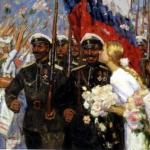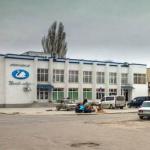No. 1" Guba Oksana Nikolaevna
Slide 3
Determine where these objects are located?
1-r. Volga
2- Moscow
4-oz. Baikal
5-volk. Klyuchevskaya Sopka
6- Yamantau
7- valley of geysers
8- Yakutsk
Which object remains undefined?
Slide 4
To determine where object No. 6 is located, try to guess the riddle:
To a solemn cry,
Add a consonant sound
So that the mountains stretch out,
From North to South.
Slide 5
Slide 6
Lesson topic:
PC of Russia: Ural. Features of nature
Slide 7
1. Show the uniqueness of the natural region - the Urals.
2.Develop knowledge about cause-and-effect relationships in nature
1. Analyze the geographic location of the Ural Mountains
2. Explain the relationship between the location of landforms and minerals and the geological structure
3.Work with atlas maps and contour maps
1.Features of the FGP of the Urals
2.Relief and its features
3. Minerals of the Urals
4. Climatic conditions of the Ural Mountains
Slide 8
Origin of the name - Ural
- In ancient sources, the Urals are partly associated with the Riphean and more often with the Hyperborean mountains
- Russian pioneers called it Stone
- The name Ural was introduced
- V. Tatishchev from the Mansi “ur” (mountain).
Slide 9
Using the map, determine the features of the geographical location of the Ural Mountains.
Slide 10
Sample control:
- Stretches from north to south along the 60th meridian
- On the border between Europe and Asia
- On the border of the Russian and West Siberian Plains
- On the border of the Volga and Ob
- On the border of temperate continental and continental climate types
- Length from north to south 2000 km
Slide 11
Based on the map and text of the textbook p. 184, determine the features of the formation of the Ural Mountains?
Draw a conclusion.
Slide 12
The Urals are ancient mountains of Hercynian folding
In the Mesozoic and early Cenozoic, their destruction occurred, and in the Cenozoic it rose a second time, but to a small height.
The mountains experienced block-vertical movements and became folded-block.
Mountains consist of several chains parallel to each other.
Slide 13
Fold-block structure of mountains
Slide 14
Slide 15
Describe the appearance of the Ural Mountains
Slide 16
Slide 17
Remnants are individual elevated elements of the relief, preserved from destruction, in the form of separate massifs
Slide 18
Weathering pillars
Slide 19
Compare the relief of parts of the Urals
Slide 20
Narodnaya - the highest point of the Urals
Slide 21
Geographic profile of the Ural Mountains
The Urals are asymmetrical mountains, because the western slope is gentle and the eastern slope is steep.
Slide 22
Minerals of the Urals
- Iron ore
- Gold
- Salt
- Potassium salt
- Copper ores
- Coal
- Asbestos
- Chrome ores
- Oil
Slide 23
Ilmensky Mineralogical Reserve
Created in order to preserve an exceptionally diverse complex of rocks and minerals, as well as fauna.
Slide 24
- January
- Determine the average January t in the northern and southern parts of the Urals
- Determine the average July t in the northern and southern parts
Slide 25
Test yourself Find errors in the text
The Urals are one of the highest mountain systems in Russia.
It was formed during the Mesozoic era of folding. The mountains consist of several chains that stretch parallel to each other in the meridional direction. The highest point is Narodnaya 2147 m. Volcanoes are located in the south of the mountain system.
The Urals from north to south can be divided into 5 parts. The main wealth of the Urals is ore, but there are reserves of coal, oil, salt, asbestos, marble, etc.
Slide 26
Resources
Physical map of Russia
View all slides
During the lesson, students consider the geographical location of the Urals. The main factors of the geographical location of the Urals are studied. Then students, using atlas maps, determine the geographical location of the Ural Mountains.
Afterwards, students become familiar with the geological profile of the Ural Mountains and the rocks that make up the mountains.
Then a diagram of the Ural Mountains is examined, showing photographs of each orographic unit of the mountains.
In the presentation, students will learn information about one of the major rivers of the Urals - the Chusovaya River.
The issue of mineral resources in the Urals is discussed separately, since the Ural Mountains are a storehouse of Russia’s mineral reserves.
At the end of the lesson, it is proposed to consider the environmental problems of the mountains.
Slide 1GP, relief, geological structure and minerals of the Urals
Slide 2Main factors of the Urals GP Borderline 1. Between two parts of the world 2. Between different parts of the earth's crust. 3. Between various forms of relief 4. Between the basins of the largest rivers. 5. Between climatic zones and regions. 6. Between several natural areas. Geographical position Deep position 2. Position on the border of Europe and Asia Ural ridge
Slide 3 Determine (using a physical map) how the geographic location of the Urals affects its nature. GP factors position inside the continent elongation from north to south accessibility to winds from the Arctic Ocean
Slide 41800m 1200m 1600m Western slope Eastern slope Main ridge Metamorphic and sedimentary rocks Igneous and volcanic rocks Metamorphic rocks East European Plain Pz Pt Pz West Siberian Plain
Slide 5 Scheme of the Ural Mountains 1. Pai-Khoi 2. Polar Ural 3. Subpolar Ural 4. Northern Ural 5. Middle Ural 6. Southern Ural 2 1 3 4 6 5
Slide 6Polar Ural
Slide 7 Subpolar Urals
Slide 8 Subpolar Urals Saber Mountain
Slide 9Northern Urals
Slide 10Middle Urals
Slide 11Middle Urals Chusovaya River
Slide 12The Chusovaya River, a left tributary of the Kama, originates in the Middle Urals and crosses it from southeast to northwest. The length of the river is about 600 km. Rocks up to 100 m high give this river its harsh beauty. The banks of Chusovaya with numerous cliffs and caves are a kind of chronicle of the Urals. The caves contain traces of the sacrifices of ancient hunters. According to legend, the squad of the legendary conqueror of the Kuchum kingdom spent the winter in the cave of the Ermak Stone.
Slide 14Southern Ural
Slide 15 Mountain of small boobies Palkinsky stone tents. Devil's Settlement How could such landforms be formed?
Slide 16 Mineral resources of the Urals Western slope Main ridge Eastern slope Sedimentary Metamorphic Igneous and volcanic Salts Coal Limestone Sandstone Gneiss Quartzite Mica Rock Crystal Dragots. stones Crystal schists Iron ore Platinum Gold Silver Copper Bauxite Minerals
Slide 17Natural uniqueness of the Urals
Slide 18Ilmen Mineralogical Reserve
Slide 19 “Mineralogical Paradise” The Ilmen State Reserve is located in the Southern Urals in the Ilmen Mountains. The reserve was created in 1920 thanks to the efforts of academician A.E. Fersman. Minerals and rocks are protected here: precious and semi-precious stones. There are more than 200 minerals in the reserve. There are some rare ones that have not yet been found in any mountains in the world.
Slide 20 “The Edge of Gems” amethyst amazonite rock crystal corundum
Slide 21mica topaz malachite topaz
Slide 22rock crystal Chalcedony rhodonite aventurine Emerald crystals Precious stones and semi-precious stones
Slide 23Turquoise Alexandrite Sapphire Ruby Diamond Precious stones and gems
Slide 24 The ornamental stones of the Urals are distinguished by their extraordinary beauty of colors: jasper, marble, variegated coils. But especially prized are: green patterned malachite and pink eagle.
Slide 25Modern products with sapphires
Slide 27 “Underground Kingdom”
Slide 28Kungur Ice Cave One of the largest caves in Russia. Located near Kungur on the right bank of the Sylva River. The ice mountain is composed of soluble water rocks: limestone, gypsum, dolomite, anhydride. The Kungur cave is the result of the dissolution of rocks (karst) by water. The cave consists of grottoes located on four tiers. The length of 58 grottoes and passages is about 5 km
Slide 29Environmental problems of the Urals
Slide 30 The Urals have been being developed for a long time. This is a large industrial region of Russia. There are especially many cities in the Middle and Southern Urals. Often the distance between cities is 5 – 10 km. In the cities of the Urals there are “dirty” industries: metallurgical and chemical enterprises. In cities, there is high air smoke (smog, acid rain), heavy metals accumulate in the soil, and rivers and lakes are polluted by industrial wastewater. Deforestation and mining (quarries, dumps) have worsened the quality of the landscapes of the Urals. Valuable coniferous trees are destroyed. In the Chelyabinsk and Orenburg regions, radioactive contamination is the result of nuclear weapons tests.
Slide 31 Leaders in the list of the most unfavorable cities for living in Russia Ekaterinburg N. Tagil Chelyabinsk
Slide 32The most polluted rivers of the Urals Iset Kosva Miass Pyshma
Slide 33Ufa Chusovaya Measures to improve the environmental situation in the Urals: use of waste-free technologies; construction of treatment facilities; reforestation; creation of nature reserves and wildlife sanctuaries.

Among the natural resources of the Urals, a prominent role, of course, belongs to the riches of its subsoil. Deposits of raw ore are of the most important importance among mineral resources, but many of them were discovered a long time ago and have been exploited for a long time, therefore they are largely depleted.





The most “mineral” place in this area is Ilmen, where more than 260 minerals and 70 rocks were discovered. About 20 minerals were discovered here for the first time in the world. Here you can find such precious stones as: sapphire, ruby, diamond, etc., semi-precious stones: amethyst, opal, topaz, granite, malachite, sun, moon and Arabic stone, rock crystal, etc.

Emerald (or green stone) is one of the most famous precious stones; it has been known since ancient times and was used as jewelry. Emeralds were found on the eastern slope of the Ural Mountains near the Tokovaya River. The deposit was accidentally discovered by a peasant in 1830 after noticing several green stones among the roots of a fallen tree.


To use presentation previews, create a Google account and log in to it: https://accounts.google.com
Slide captions:
Mineral resources of the Urals Plaksina L. G. geography teacher, Municipal Educational Institution Secondary School No. 4, Karabash
The Taganay and Yurma ridges are composed mainly of quartzites. The Urals are a vast mountainous country stretching for almost two thousand kilometers. The Ural Mountains are the only ones on Earth that divide an entire continent into two parts of the world - Europe and Asia. Scientists say that today we see the remains of the once highest mountains on the planet. The sun, wind, water and ice destroyed these majestic mountains for millions of years. Everything that was once hidden at great depths is now practically on the surface. The mineral resources of the Urals are distinguished by their richness and diversity of species. Huge deposits of most metals, valuable deposits of precious stones and inexhaustible reserves of mineral raw materials are found here.
The natural resources of the Urals are very diverse and have a huge impact on its specialization and level of development. The Ural economic region has mineral resources, fuel, and non-metallic minerals. In terms of reserves of certain types of mineral resources (copper ores, asbestos, potassium salts), the Urals occupies a leading place in the world. Fersman called the Ilmen Mountains a mineralogical paradise. In 1920 they were declared a mineralogical reserve. Cuprite, Mednorudyanskoe deposit, Nizhny Tagil, Ural Beryl. Murzinka, Middle Urals
Deposits of iron ores and non-ferrous metal ores are concentrated mainly within the Ural Mountains. In the Urals, over 2 thousand deposits of iron ore are known, of which 75 are balance deposits, 29 are exploited. In terms of iron ore mining, the Urals are second only to the Central Chernozem economic region. Nevertheless, only 3/5 of the region's needs for iron ore are met through its own production. Currently, the development of low-grade ores of the Kachkanar and Bakal groups of deposits is underway, in which 3/4 of the reserves of the Ural iron ores are concentrated. Only due to the fact that the ores are multicomponent and also contain vanadium and titanium, their extraction is profitable. Pyrite, malachite are satellites of copper. Ilmenite is a mineral of iron and titanium. First found in the Ilmen Mountains
Refractory, construction, abrasive, molding and various other non-metallic minerals, many of which are absolutely necessary for the metallurgical and engineering industries, are available in huge quantities in the depths of the Chelyabinsk region. Clays and kaolins, limestones and dolomites, magnesite, marble, gypsum, roofing slates, tripoli and diatomites, talc and talc stone, quartz, graphite, corundum, garnet, barite, asbestos, kyanite, jasper, jades and a wide variety of construction, facing and ornamental stones form here the countless natural resources of the region and put it in this regard as one of the very first places in the world. Various granite – facing igneous rock
The Urals are distinguished by large reserves of various non-ferrous metal resources. These are copper ores (Krasnouralskaya, Karabashskaya, Kirovogradskaya, Gaiskoye, and other deposits), zinc ores (mainly copper-zinc), and nickel ores (Verkhniy Ufaley, Orsk, Rezh). There are significant resources of aluminum raw materials (bauxite), concentrated in the North Ural bauxite basin (Krasnaya Shapochka, Severnaya, Sosvinskoye, etc. deposits). True, many bauxite deposits have already been depleted. The extraction of gold, precious and ornamental stones plays an important role. Smelting copper ore at the Karabashmed plant
The fuel resources of the Urals are represented by all main types: oil, natural gas, coal, oil shale, peat. Oil deposits are concentrated mainly in Bashkortostan, the Perm and Orenburg regions and in Udmurtia, natural gas - in the Orenburg gas condensate field, which is the largest in the European part of the country.
The Urals have large resources of potassium and table salts. One of the largest salt-bearing basins is located here - Verkhnekamensky, its balance reserves in all categories amount to over 173 billion tons. It should also be noted that the Iletsk deposit of table salt in the Orenburg region. But in the Urals there are especially many varieties of silica Halite (table salt), crystals on gypsum.
Did you know that... silica compounds are the most common on Earth (jasper, quartz, agate, chalcedony, onyx, opal, quartzite and much more...)
Did you know that... chalcedony is the name given to variously colored varieties of cryptocrystalline quartz. Agates are differently colored zonal formations of chalcedony. Since ancient times, cameos and gems have been carved from multi-layered onyx (agate with alternating light and dark stripes).
The main industrial reserves of asbestos in the country are concentrated in the Urals: Bazhenovskoye (Sverdlovsk region) and Kiembaevskoye (Orenburg region) deposits. There are deposits of clays, sands, limestone, marbles, slates, etc. Prokhorovo - Balandinskoye marble deposit Quarry of construction slate-flagstone
Did you know that... It is in the Urals that there are deposits of precious stones. For example, the mineral emerald, a bright green variety of beryl?
The yellowish-green stone is chrysoberyl (true beryl). This stone helps in scientific research and philosophy. Beryl makes a person cheerful, cheerful and friendly. Brings success to the opposite sex. In ancient times, beryl was considered a purely feminine stone: it was used in the treatment of female diseases. Ancient sorcerers, with the help of chrysoberyl, learned to understand the language of animals and birds and read the future. Do you know that…
Emerald is deep green or the color of spring grass. The following beryls are distinguished: augustite - dark blue, aquamarine - aquamarine, just beryl - colorless or very lightly colored samples; heliodor - yellow; Geschenite - apple green. There are several varieties of beryl:
1. Chalcedony is: a type of amethyst; igneous rock; cryptocrystalline type of silica 2. The structure of agate is characterized by: solidity; various spots; banding. 3. The Taganay Mountains are composed of: Marbles; quartzites; granites. 5 . Aquamarine has a color: sea green; carrot colors; seaweed colors. . 5. Emerald is: Noble turquoise; a bright green variety of beryl; blue sapphire 6. Fersman called a mineral paradise: Hermitage Museum Ilmen Mountains Lake Turgoyak 1 2 3 Choose the correct answer (if the color is red when clicked, then the answer is incorrect) 1 1 1 1 1 2 2 2 2 2 3 3 3 3 3
http://riaural.ru/prirodnye-resursy-urala.html Website natural resources of the Urals http://vasi.net/uploads/podbor/karabash/thumbs/ceh00000.jpg Copper smelting at the Karabash Copper plant http:// geo.web.ru/druza/m-Be_el.htm Website about minerals (beryl) http://geo.web.ru/druza/m-Be_7_6778_Fers.JPG Yellow beryl from the Middle Urals http://geo.web.ru /druza/m-Be_7_2172.JPG Beryl from Murzinka http://geo.web.ru/druza/m-Tucs07_786.JPG Emeralds http://geo.web.ru/druza/m-izum_28_Mu-08_279_Moi.jpg Many emeralds http://geo.web.ru/druza/m-Tucs07_1100117.JPG Multi-colored varieties of beryl http://vestnik.rosneft.ru/img/cont/v66_19_1.jpg Oil in the palms http://geo.web.ru/ druza/m-cuprit_NTg.JPG cuprite http://geo.web.ru/druza/m-halit_gyps.JPG Halite http://geo.web.ru/druza/m-chalc_Kant_2_1.JPG Chalcedony tea leaves color http:// gorod.tomsk.ru/uploads/41829/1257924600/1_1.jpg Cameo from onyx http://geo.web.ru/druza/m-agat_6U-2a.JPG Blue agate http://geo.web.ru/druza /m-ilmen_7_1753_Zr.JPG Ilmenite Slides 1,2, 5,8,11, partially 4 – photo by the author




